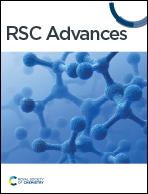Pr2Ni0.8Co0.2O4+δ impregnated La0.6Sr0.4CoO3−δ oxygen electrode for efficient CO2 electroreduction in solid oxide electrolysis cells†
Abstract
The solid oxide electrolysis cell (SOEC) is an advanced electrochemical device with a promising future in reducing CO2 emissions. Currently, the insufficient oxygen evolution reaction activity in conventional anode materials severely restricts the development of electrolytic CO2. Herein, the PNCO–LSC composite oxygen electrode was exploited by impregnating Pr2Ni0.8Co0.2O4+δ (PNCO) on the surface of La0.6Sr0.4CoO3−δ (LSC) oxygen electrode. The results of electrochemical tests and various physicochemical characterizations indicate that the infiltration of PNCO can lead to a significant improvement in the performance of the cell for CO2 electroreduction by increasing the surface oxygen exchange. The current density of the PNCO–LSC oxygen electrode infiltrated twice at 800 °C and 1.5 V reaches 0.917 A cm−2, which is about 40% higher than that of the bare LSC oxygen electrode. In addition, the single cell did not show significant degradation in a long-term stability test at a current density of 0.4 A cm−2 for 100 h of electrolysis. Therefore, the PNCO–LSC composite oxygen electrode material is effective in enhancing electrolytic CO2 performance.



 Please wait while we load your content...
Please wait while we load your content...